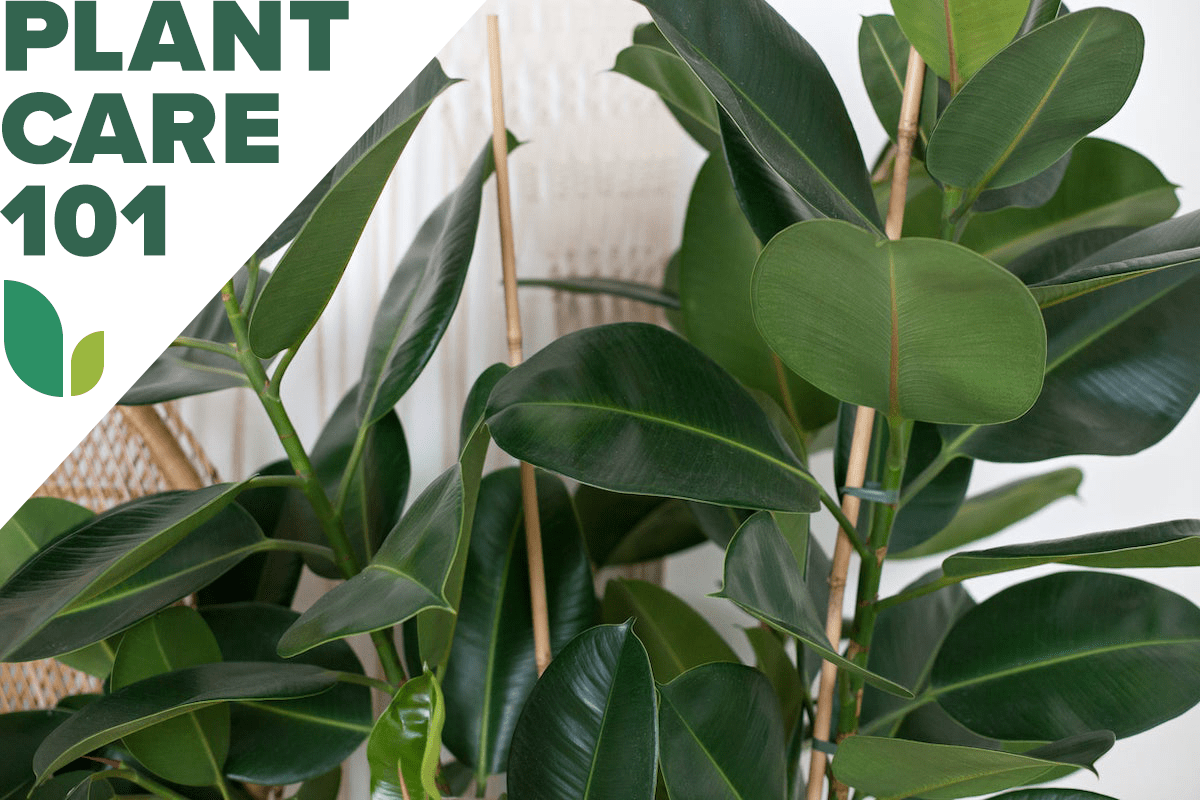

We may earn revenue from the products available on this page and participate in affiliate programs. Learn More ›
Ficus elastica, better known as the rubber plant, gets its name from the latex it produces that once was used to make rubber. Also known as rubber fig, rubber bush, and rubber tree, this species is part of the fig genus. These tropical evergreen trees have become ubiquitous around the world as houseplants.
Read on to learn all about rubber plant care, including its soil, light, water, and temperature needs.
Rubber Plant Care At a Glance
Common Name: Rubber plant or rubber tree
Scientific Name: Ficus elastica
Soil: well-draining, pH 5.5 to 7
Light: bright, indirect light
Water: once per week during the growing season
Food: 24-8-16 fertilizer
Temperature and Humidity: high humidity, 65 to 85 degrees
Propagation: 6-inch cuttings with 4 nodes
Safety: toxic and irritating to eyes and skin
Rubber Plant Characteristics
Rubber plants are native to South Asia, but over the years have become naturalized in Sri Lanka, the West Indies, Hawaii, and Florida. Rubber plants have thick, dark green leaves and typically grow to heights of between 100 and 130 feet in the wild, though some have even been known to grow to nearly 200 feet.
In their natural habitat, the plants’ trunks are approximately 6 feet 7 inches in diameter. When grown indoors, rubber plants become medium-sized houseplants or can grow into small trees with a maximum height of between 8 and 10 feet. It’s best to buy rubber plants when they are young so that they can adapt to growing indoors. To restrict its growth, keep the rubber plant in a small pot.
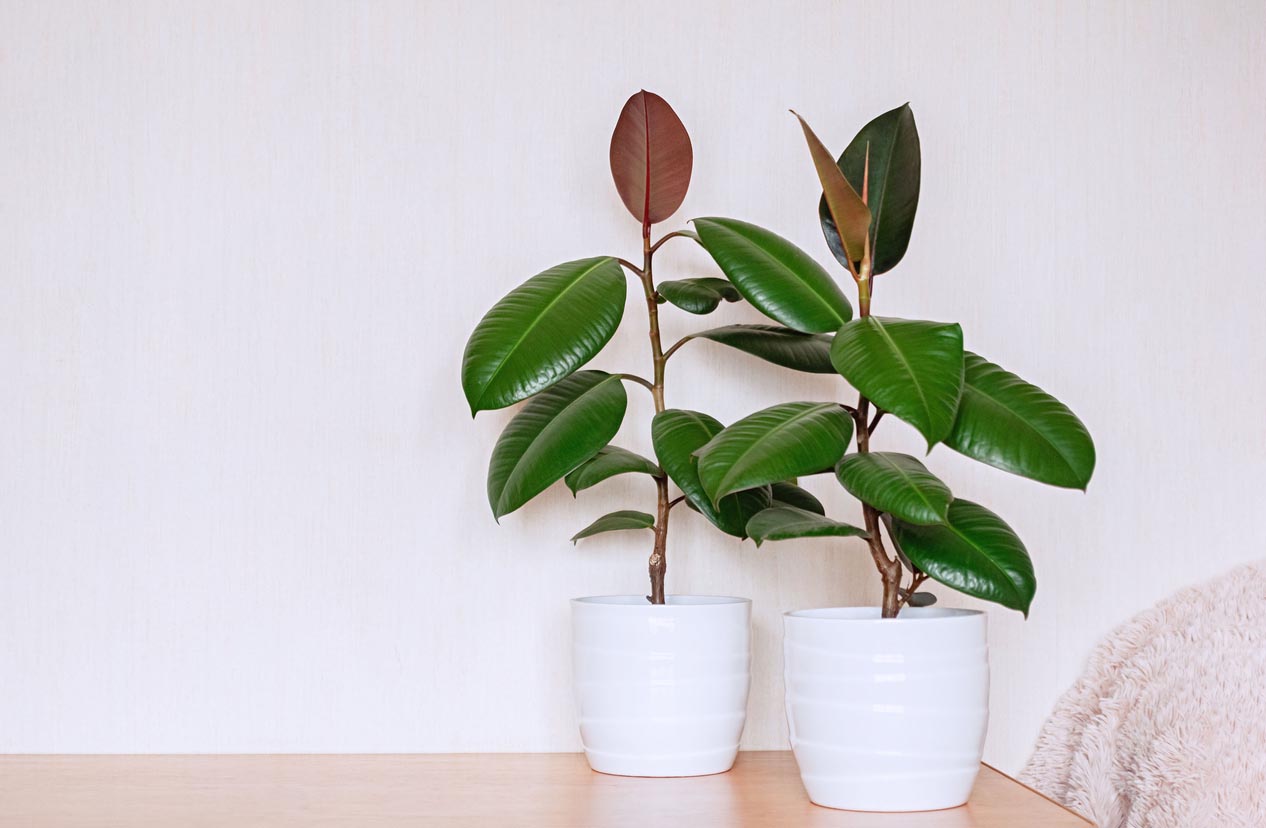
Related: 20 Huge Houseplants That Make a Statement
Types of Rubber Plants
- Ficus elastica ‘Robusta’ is the most common variety, with large green leaves.
- Ficus elastica ‘Tricolor’ has the same thick, leathery leaves as the common variety, but comes in a mix of three colors: green, pink, and cream.
- Ficus elastica ‘Tineke’ has pink stems and leaves that mix dark and light green with cream.
- Ficus elastica ‘Decora’ has large, shiny leaves that grow up to 12 inches long.
- Ficus elastica ‘Doescheri’ has blotched leaves with pink accents on the stalks’ undersides.
- Ficus elastica ‘Burgundy’ has dark crimson leaves that appear almost black in certain lighting.
Selecting Soil for Rubber Tree Plants
Rubber plants require well-draining soil to avoid getting root rot. The soil needs to drain completely between waterings. They do, however, appreciate soil with good water retention that doesn’t dry out too quickly. Essentially, rubber plants need soil that remains moist without becoming soggy. The ideal mixture includes 1 part peat, 1 part pine bark, and 1 part sand.
The Right Light
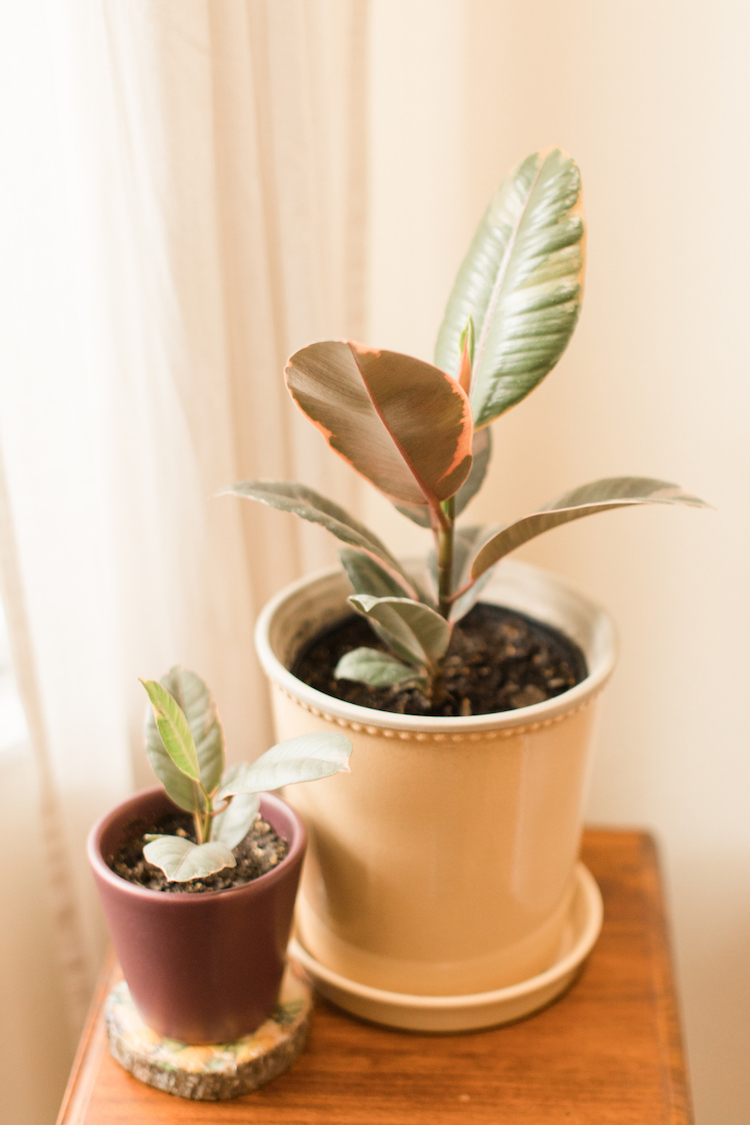
Rubber plants thrive with bright, indirect sunlight. Ideally, they should receive morning light from an east-facing window. Place your plant near a window where a sheer drape or curtain filters the light.
Avoid placing your rubber plant in a spot that receives direct sunlight because the leaves can begin to burn. They can also learn to tolerate low light conditions and can survive in offices and other poorly lit areas. If you notice the leaves becoming paler or the bottom leaves falling off, it’s a good indication that your rubber plant needs more light.
Watering Rubber Trees
During their growing season, which occurs during the summer in most climates, keep the soil moist. Water the plant once a week and mist the leaves with water or gently wipe them with a damp cloth. In the winter, when rubber plants are dormant, it’s okay if the soil becomes dry between waterings. Water them every 2 to 3 weeks during this time. Leaves turning brown or yellow is a sign of overwatering, while drooping leaves are a sign of underwatering.
Fertilizing Rubber Plants
Fertilizing rubber plants will make them grow taller and bushier. Signs of under-fertilization include stunted growth, yellowing or browning leaves, and drooping leaves. Fertilize rubber plants every 2 weeks during the growing season using a water-soluble houseplant fertilizer. The ideal fertilizer has a 24-8-16 ratio, which includes 24 percent nitrogen, 8 percent phosphorus, and 16 percent potassium.
Choose a liquid, granular, or pellet fertilizer. When in low-light conditions, rubber plants can tolerate more infrequent fertilization. Overfertilizing can cause rubber plants to become leggy.
Related: Count On These 25 Indoor Plants for Easy Color Year-Round
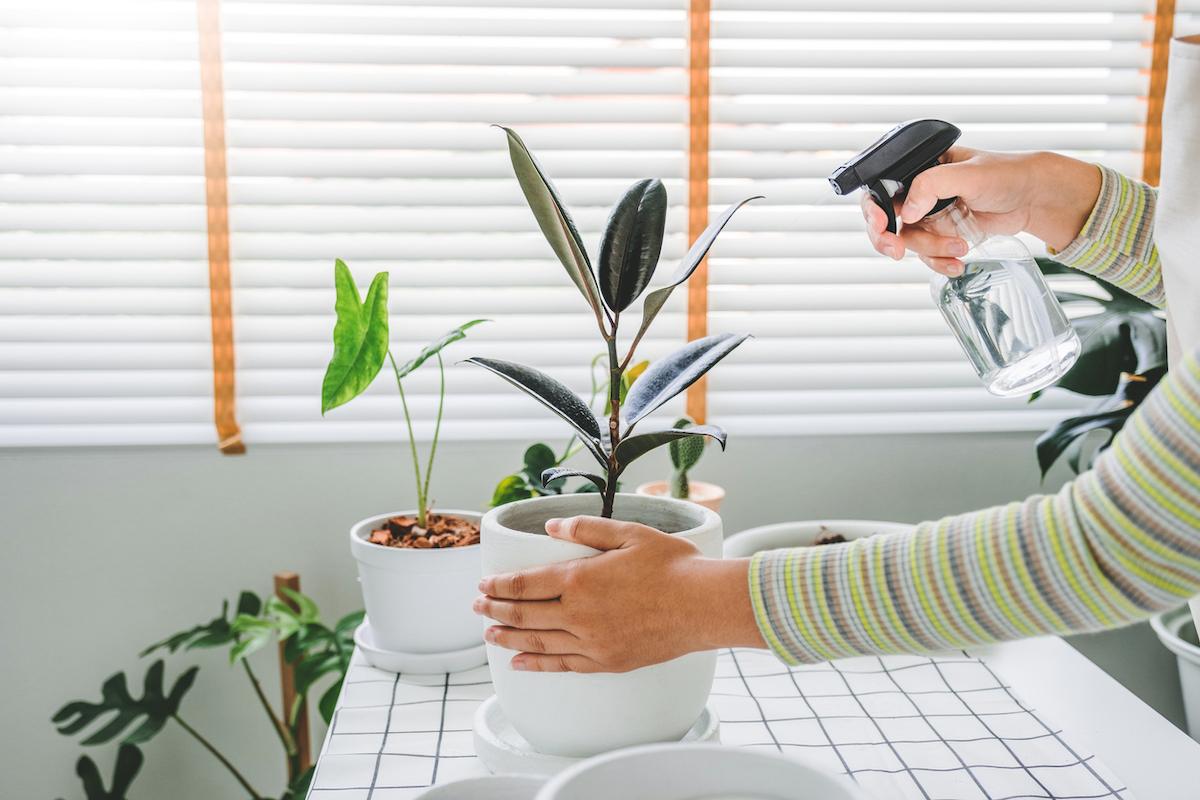
Setting the Temperature and Humidity
Indoors, rubber plants do best in temperatures between 65 and 85 degrees. Putting a rubber plant outdoors during the summer will help it grow more quickly. In fact, in USDA hardiness zones 10 and 11, the plants sometimes can grow outdoors year-round. Make sure to bring a rubber tree inside for the season as soon as temperatures fall below 65 degrees.
Due to their tropical origins, rubber plants thrive in humid conditions. If your home is particularly dry due to the climate or to indoor heating, consider misting the leaves year-round.
Propagating Rubber Plants
Rubber plants are easy to propagate. Simply cut off a stem and dip it in a rooting medium after the sap has dried. Make sure each cutting is at least 6 inches long and includes four leaf nodes. Remove the bottom leaves from the cutting, leaving 2 or 3 leaves at the top.
Plant the stem in soil and consider placing its container on a heating pad to encourage rooting. As a general rule, it’s preferable to propagate houseplants in the early spring to late summer, during their growing period.
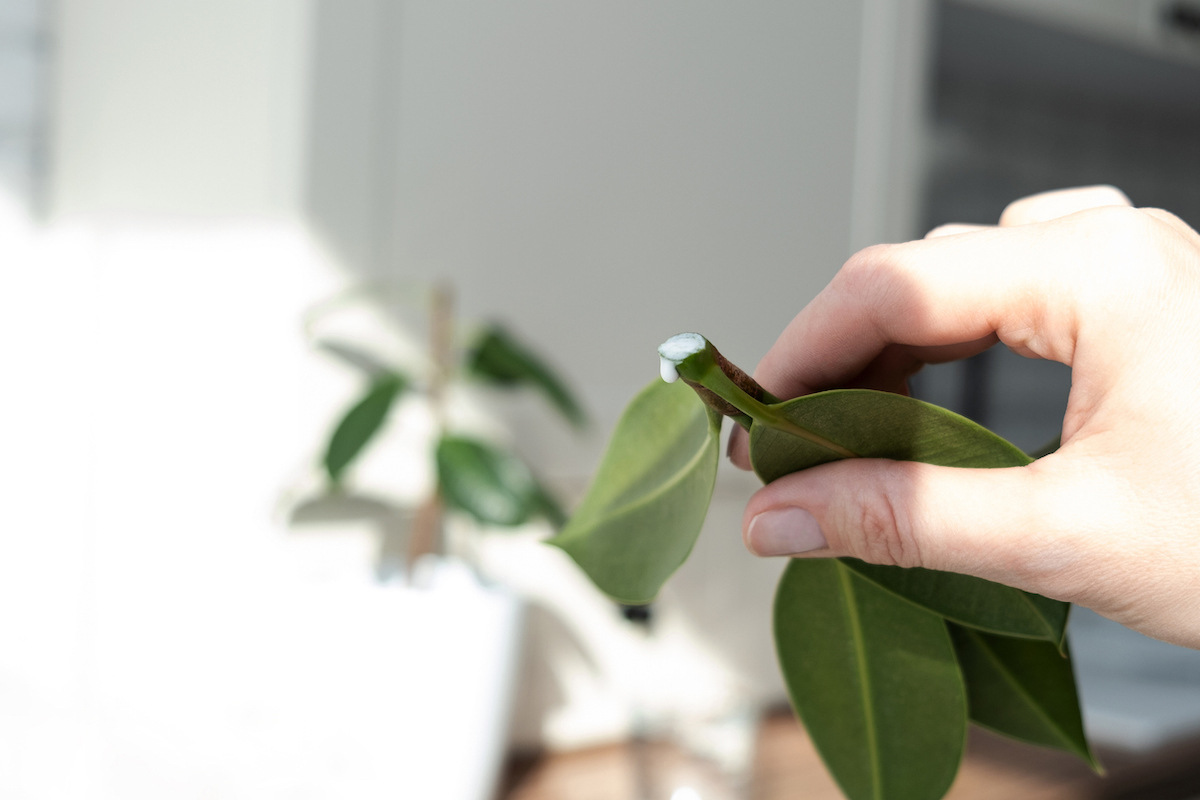
Safety Considerations
The milky white latex that rubber plants produce is irritating to the eyes and skin, so it’s essential to wash your hands after interacting with the plant. It’s also toxic if consumed, so it’s crucial to keep rubber plants out of reach of pets and young children.
Potential Pests and Diseases
Rubber plants are generally resistant to pests, but they are still susceptible to the occasional infestation. Some of the most common culprits are aphids, spider mites, thrips, and scale. If you notice pests on your rubber plant, use a natural or chemical insecticide to eradicate them. Neem oil and other horticultural oil will also help to rid your plant of insects.
Rubber plants might suffer from root rot due to overwatering. If you notice the leaves drooping or yellowing, be sure to let the soil dry out completely before watering the plant again.
Related: The Best Indoor Gardens for Flowers and Herbs, Tested
FAQs About Rubber Plant Care
While you’ve learned more about rubber plant care, you may still have some questions about their maintenance needs.
Q. How often should I water my rubber plants?
In the summer, water your rubber plants once a week. In the dormant season, water 2 or 3 times per month.
Q. Where should I place my rubber plant in my house?
Ideally, place your rubber plant in indirect sunlight from an east-facing window.
Q. Can my rubber plant survive in low light?
Yes, while rubber plants generally prefer strong, indirect sunlight, they can also learn to survive in low-light conditions, especially if you start them in their conditions while relatively young.
